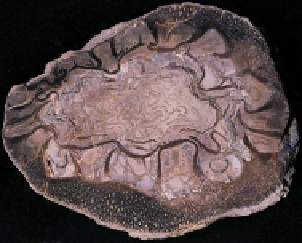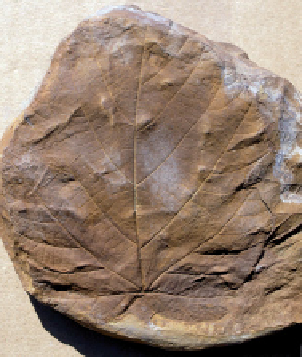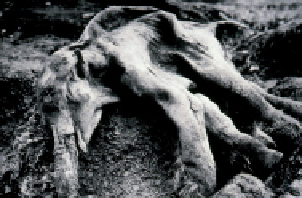Geoscience Reference
In-Depth Information
hard parts will be less likely to be preserved than those with
some durable components. Thus, vertebrate bones and thick
calcareous shells from invertebrates have a high preservation
potential. Some plant parts such as pollens and spores have
outer coats made of an organic polymer known as sporopollenin
and this is extremely biologically and chemically resistant.
Thus pollens and spores have a high preservation potential.
Wood and leaves are more likely to decay but even these can
have their preservation potential increased dramatically by
being charcoalifi ed by partial burning prior to burial.
Surprising as it may seem charcoalifi cation preserves detail
even at the subcellular level while simultaneously rendering
the remains biologically inert by reducing them to almost pure
carbon. Some of the best three-dimensionally preserved early
fl owers are in the form of fossil charcoal (fusain).
1m
5
(a)
1cm
5.2.3 Trace fossils
Although the body parts of organisms that make trace fossils
are almost always missing, the trace shape and context can tell
us a lot about environmental conditions at, and after, the time
the trace was made. Trace fossils have the advantage over body
fossils in that they cannot be reworked, although they can be
disrupted or destroyed by later trace fossils. Trace fossils fall
into several categories based on behaviour (Appendix A5,
Figure A5.3).
(b)
1cm
Trace fossils do not occur randomly but are repeatedly found
in recognizable associations with particular sediment types.
These associations form ichnofacies that can indicate a lot
about the conditions under which sediment was deposited. In
the fi eld, using photographs and sketches, record the following:
•
the size distribution;
•
geometries (including working out which are different
cross-sections through the same type of trace fossil);
(c)
1cm
•
associations with other trace fossils;
•
characteristics of the sedimentary deposits (Chapter 6);
•
frequency and density (Section 5.5);
•
presence/absence of burrow wall linings (e.g. made up of
organic matter, shell fragments or different sediment types,
etc.) - the infi lling of burrows is also important to note in
Figure 5.3
Modes of fossil preservation: (a) Mummifi ed body of a
young mammoth found in Siberia; (b) polished transverse section of a
permineralized (petrifi ed) tree fern stem; (c) cast of a tree fern trunk;
(d) leaf impression from the north slope Alaska. (a-d: Robert A. Spicer,
The Open University, UK.)
(d)













